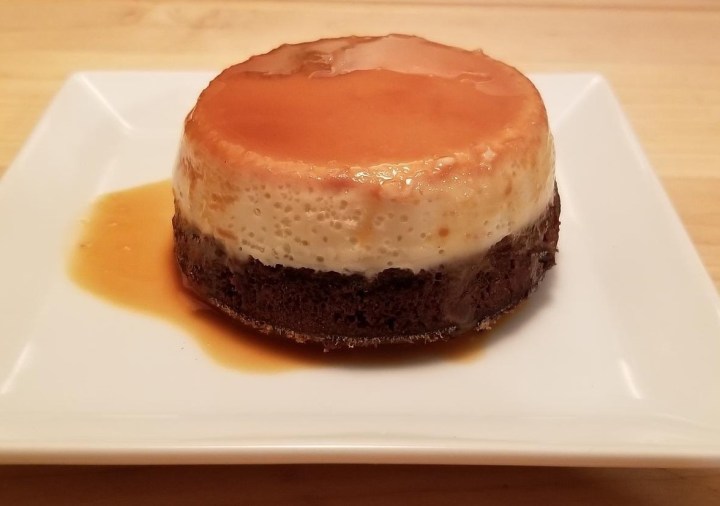
Click here to go to printable recipe: Chocoflan
Chocoflan is a delightful dessert for which a layer of goat’s milk caramel (cajeta) is poured at the bottom of a baking pan, followed by chocolate cake batter, and topped with Mexican custard (flan) mix; it has also been named pastel imposible – Impossible Cake because, after baking, the cake layer “magically” appears at the top, so when the cake is turned upside–down onto a serving plate, the beautiful flan sits on top of the cake, all covered with delicious cajeta (photo at the top of the post.)
It really is not hard to explain this phenomenon; it all has to do with the density of the different components involved. Regardless of how the layers are poured into the pan, they will tend to rearrange themselves in order of density, the one with the highest one at the bottom. In this case, the highest density is for cajeta, with milk caramels having an average density of 1.89 g/cm³; custard is next, with 1.07 g/cm³. Chocolate cake batter is the most complex component, because it includes dry ingredients (flour, cocoa powder, sugar, leavening agents), wet ingredients (fat, eggs, milk) and also has a fair amount of bubbles, created either by air (from beating before baking) or CO2 (from the leavening agents’ reaction, ignited during baking). There are mixes with high densities, such as 1.18 g/cm³ for Cake Boss™ Milk Chocolate mix to the very low density of Devil’s cake mix, at 0.7 g/cm³. This means that a cake mix with very low density might show the shift to the top even before baking, while a higher density cake mix might stay initially at the bottom, and migrate to the top as the batter cooks and CO2 is released, creating bubbles and considerably reducing the density of the cake.
For this post, I mixed my own chocolate cake batter and flan mix, and used homemade cajeta from a previous post. Although I did not measure their densities, I thought it would be interesting to test the relative densities of my chocolate cake and flan by pouring in different order, to see which one would stay on top before (and after) baking. First, I lightly greased two small moulds, and because cajeta is sticky, and by far the item with the highest density, I spread a layer at the bottom of both moulds:
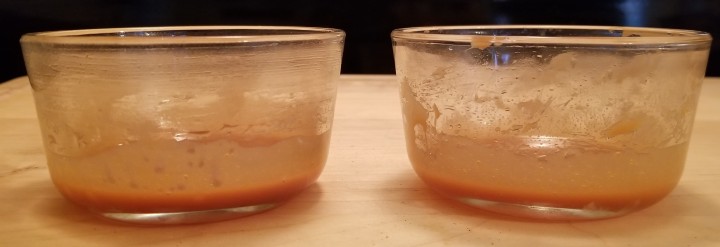
I poured flan mix first and chocolate batter second, for one mould (left) and the opposite for the other mould (right). The chocolate batter went right to the bottom for the left mould, and remained there in both cases:

That meant my chocolate cake batter’s density was high, probably too close to the flan mix’s so the movement to the top was too slow to detect. The photo below shows the same moulds, after baking, partially immersed in water, at 350°F:

Both show the same layering from bottom to top: cajeta, flan and chocolate cake. The baking powder and soda in the cake batter created bubbles, lowering the density and causing the cake to move to the top of the moulds! The photo at the top of the post shows one of the cakes, flipped onto a serving plate.
Chocoflan
Ingredients (enough for 8 cups, plus some extra cake batter)
1 cup cajeta (click here for my recipe, or bottled)
Vegetable oil, for greasing the moulds
For the flan:
6 eggs
3 cups milk
½ cup sugar
2 tsp vanilla
For the chocolate cake:
2 cups flour
1 ¾ cups sugar
½ cup cocoa powder
1 tsp baking powder
1 tsp baking soda
1 ½ cups milk
½ cup oil
1 tsp vanilla
2 eggs
I used four small 1-cup moulds and a Bundt cake mould. Lightly grease bottom and sides of moulds with oil. Spread a layer of cajeta to cover the bottom and about 1 cm up the walls of the moulds:
Set moulds aside.
Prepare cake batter: Mix dry ingredients (flour, sugar, cocoa powder, baking powder and baking soda) in a large bowl (photo below, left). Add milk, oil, and vanilla (photo below, right):
Using and electric mixer, beat mix at high speed until smooth. Continue mixing, adding eggs, one at a time, and scraping sides down with a spatula (photo below, left). Mix for another minute, until batter is uniform and shinny (photo below, right):
Set aside. Preheat oven to 350°F (180°C).
Prepare custard mix: Place all ingredients in a blender jar (photo below, left). Process until foamy and uniform ( photo below, right):
Fill about 1/3 of each prepared mould with cake batter, then fill with custard mix, to about 1/4 from the top (photos below):
This proportion is necessary so that, when the cake rises during baking, the final layers will have almost equal thicknesses. Cover each mould with Al foil, and arrange in a rimmed tray. Place tray in the pre-heated oven, and carefully pour hot water in the tray, to fill it halfway. Bake for 30 minutes, then check the largest mould with a toothpick, which should come out clean when cake is done; continue baking and checking every five minutes. My ring took 45 minutes, but a solid circle might take longer, up to one hour. (NOTE: there will be some leftover cake batter; I poured it into four cupcake moulds and baked, uncovered, next to the tray). Remove from the oven, uncover, and let cool completely before attempting to remove from the moulds:

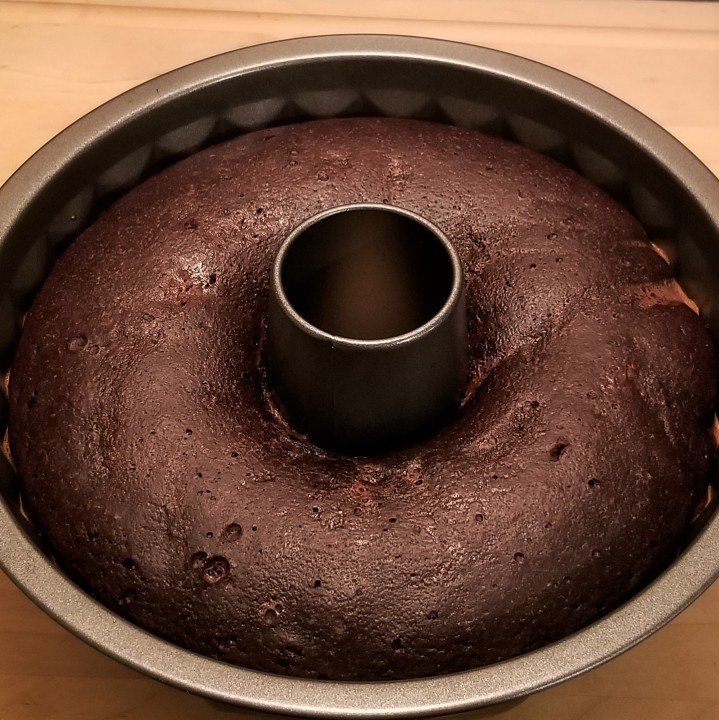
Once completely cooled to room temperature, loosen sides carefully with a spatula; place a serving plate upside-down on top of the mould and flip. Remove mould; I drizzled some extra cajeta on top:

Note that my Bundt shape has some chocolate cake on the sides; this is probably because the walls of the mould had a pattern, which ended up trapping some batter as it was moving up. However, the cross-section had well defined layers, with roughly equal thicknesses:

The small moulds came out easily and also had a nice proportion between the cake and the flan layers:

The first time I ever tried chocoflan was at a hotel in Monterrey, in the Mexican state of Nuevo Leon, in 2006. My friend Lucy (who currently owns a dessert business in Mexico City specializing in the best flan in town) told me that around that same time, she was living in Veracruz (an important port and city in the Mexican state of Veracruz) and she introduced chocoflan as an alternative to her specialty, since people in the port favoured cake to pair with a cup of their excellent coffee (The terrain and climate of Veracruz provide precious conditions for crops of strongly bodied coffee beans). Nowadays, chocoflan is a very popular dessert nationwide; it may be found packaged at grocery stores:
And offered in restaurant menus, such as the take-out slice shown below, from a Panama™ restaurant in Culiacan, in the Mexican state of Sinaloa:
In the slice above, note how the cake layer is much thicker than the flan; this is not the ideal ratio for this dessert, as explained before. The cake batter and custard mix were probably poured in equal amounts, and the cake ended up rising to almost double the amount of flan.
After explaining the processes behind this recipe, Chocoflan might not qualify with the bombastic adjective of “impossible” anymore, but it is still quite remarkable that the rising of the cake happened quickly enough to make it move to the top before the custard mix set into a solid flan. For a lighter experience, using a cake recipe with a lower density, such as devil’s food cake, should send the batter to the top even before baking.
I am bringing my recipe to Thursday Favourite Things #435 with Bev @ Eclectic Red Barn, Pam @ An Artful Mom, Katherine @ Katherine’s Corner, Amber @ Follow the Yellow Brick Home, Theresa @ Shoestring Elegance and Linda @ Crafts a la Mode. Special thanks to Bev for featuring my Cod Stew at her party.
I am joining Full Plate Thursday #480 with Miz Helen @ Miz Helen’s Country Cottage. UPDATE: Special thanks to Miz Helen for featuring this recipe at her Full Plate Thursday # 481 party.
This is a great dessert to have with a cup of tea, too! I am linking to Su’s Tea Time in the Blogosphere.
I am also joining Classy Flamingos Blog Party #98 with Linda @ poinsettiadr.com.
I am bringing my recipe to Fiesta Friday #324 withAngie @ Fiesta Friday, this week co-hosting with Diann @ Of Goats and Greens and Liz @ Spades, Spatulas & Spoons. UPDATE: Thank you so much to Angie, Diann and Liz for featuring this recipe at Fiesta Friday # 325.
I am sharing my recipe at What’s for Dinner? Sunday Link-Up #249 with Helen @ The Lazy Gastronome. UPDATE: Extra thanks to Helen, for featuring this recipe at her party #250.
I am also sharing my recipe at Over the Moon #221, graciously hosted by Bev @ Eclectic Red Barn, and Marilyn @ Marilyn’s Treats.

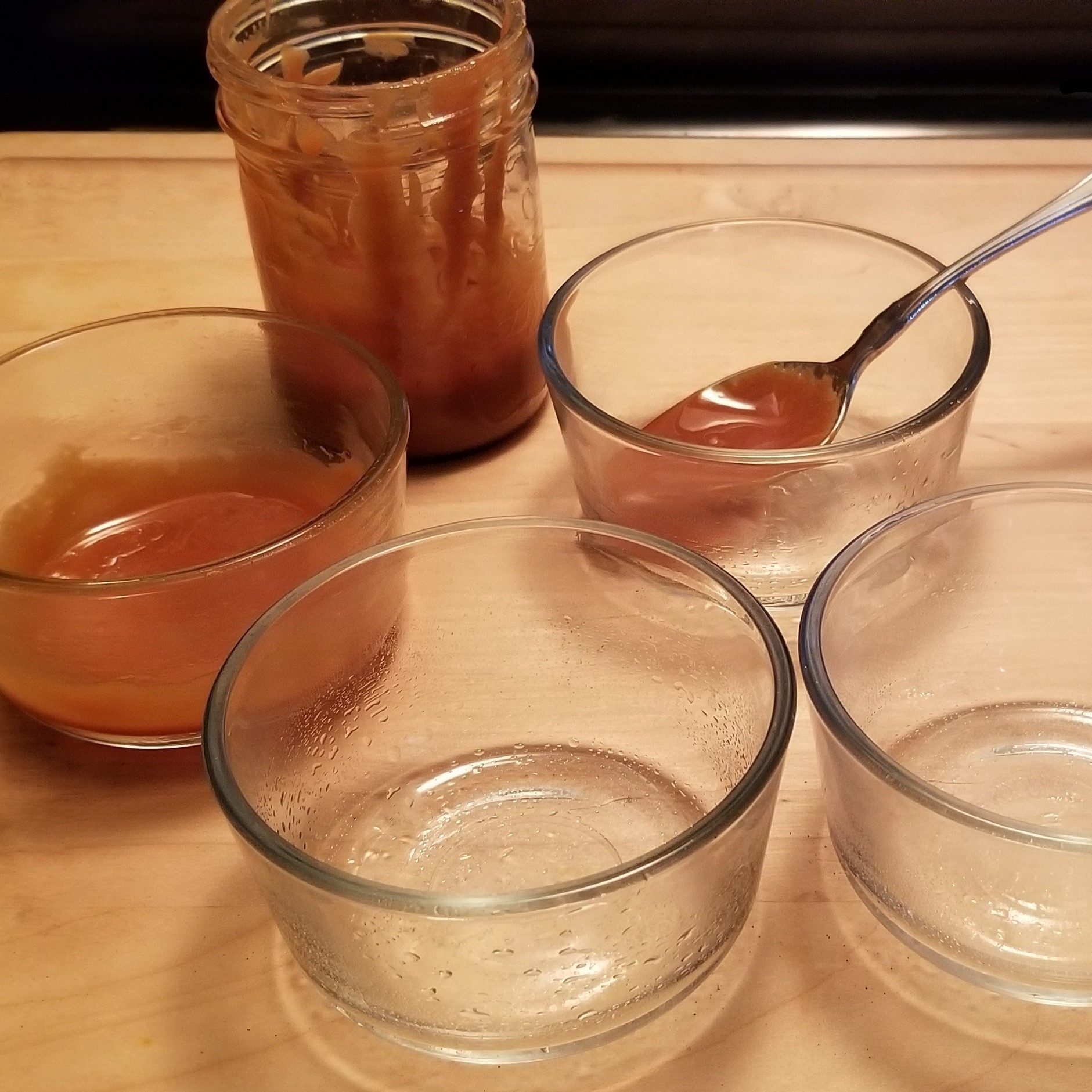









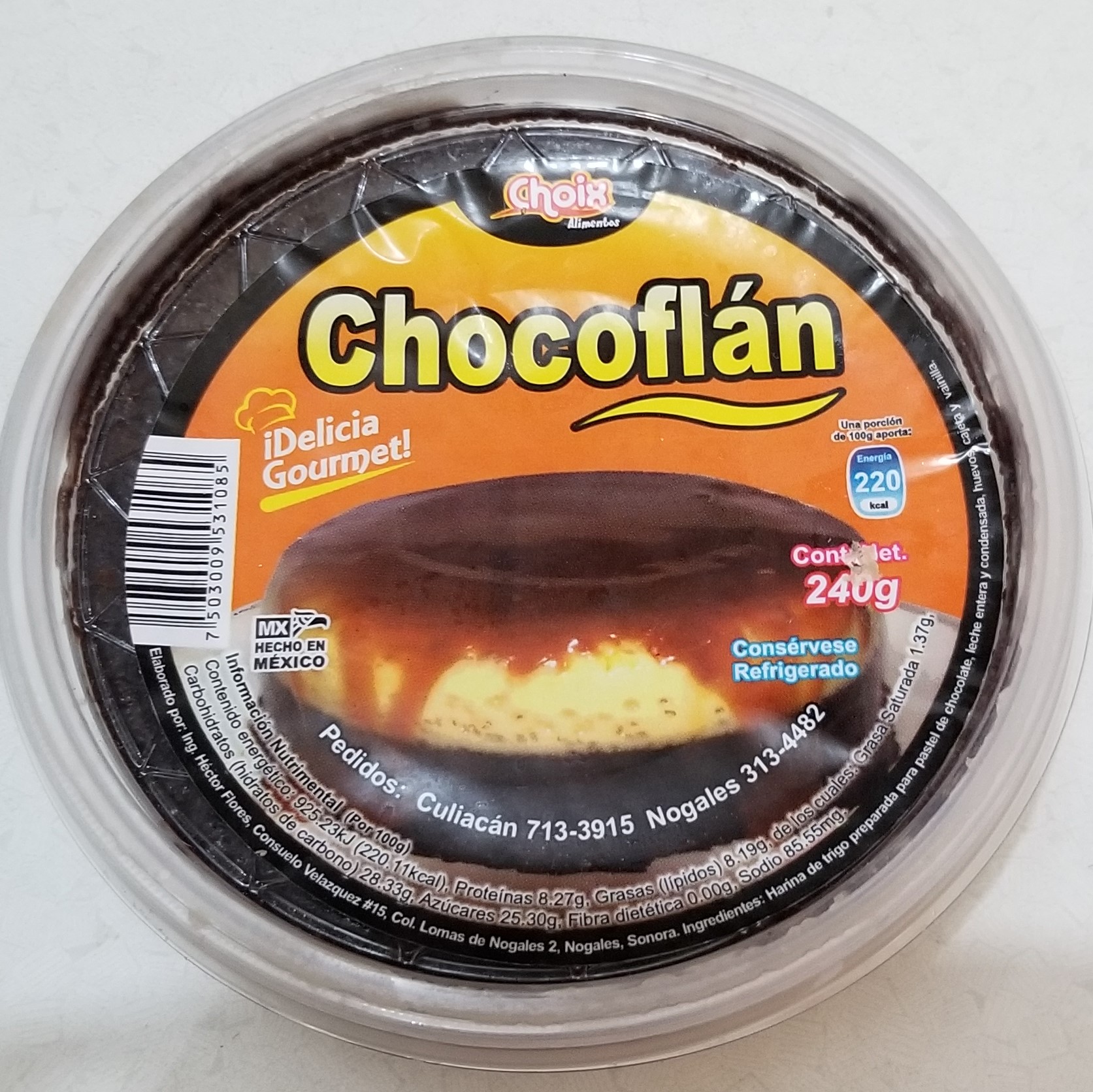
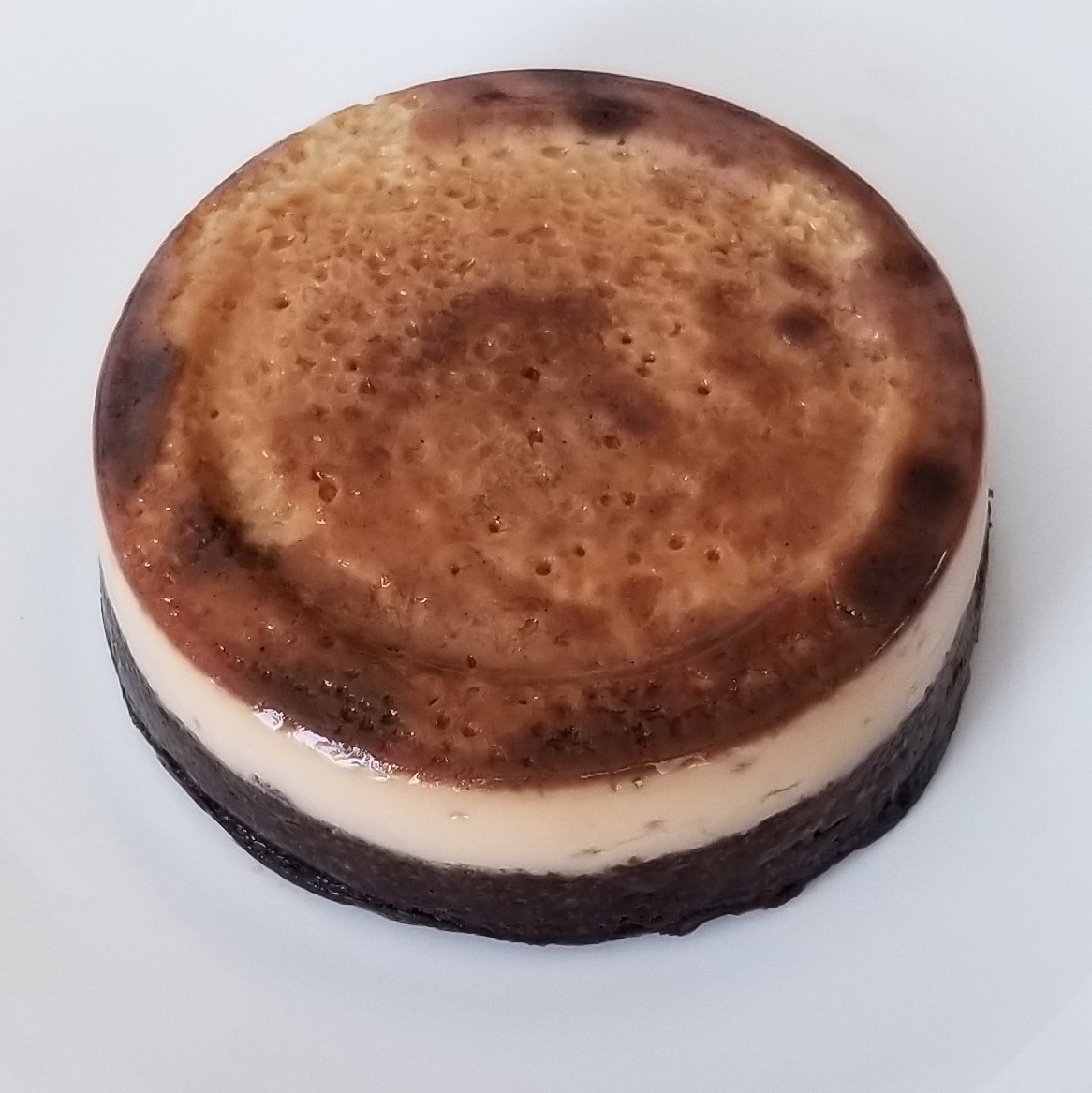

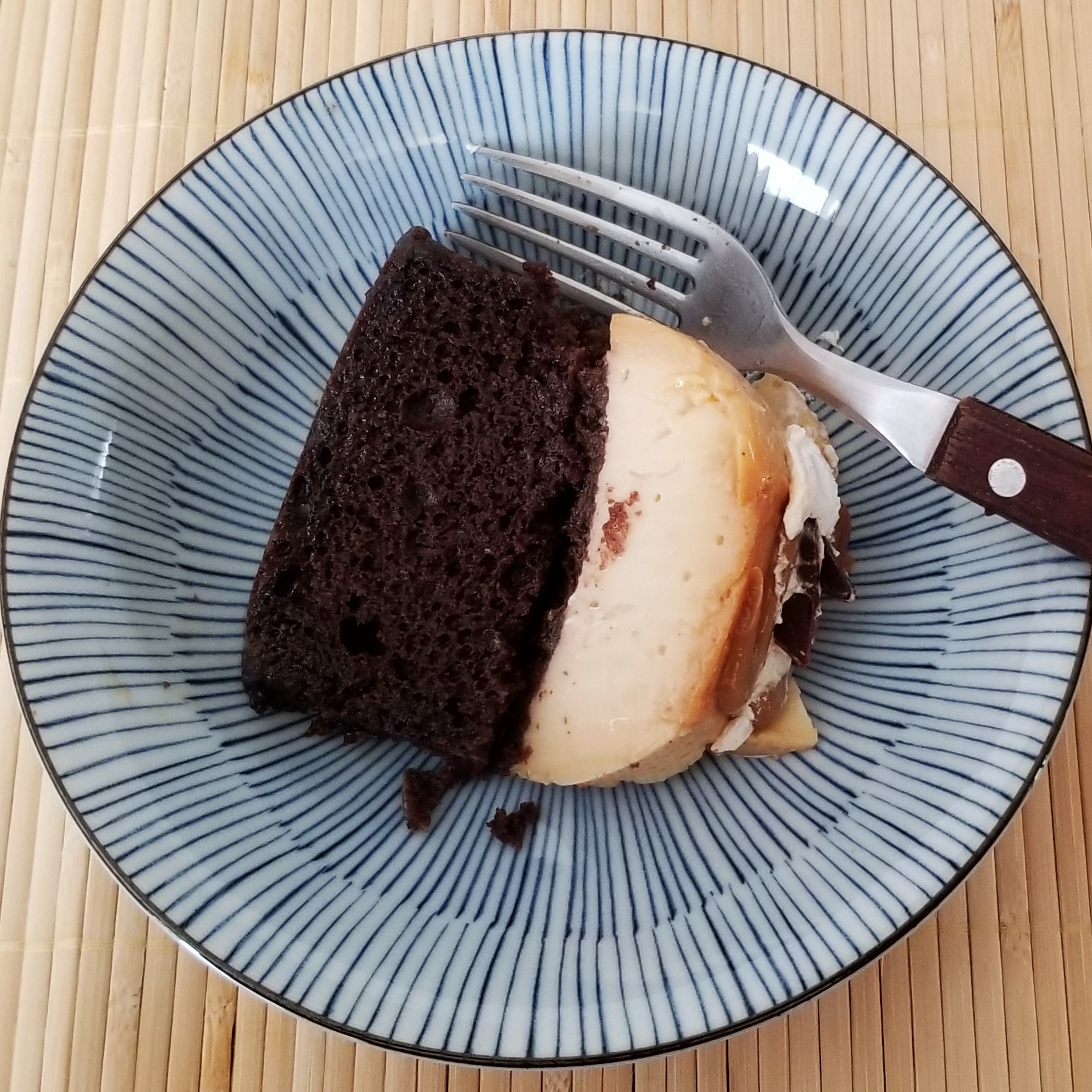







Sounds impossibly delicious
LikeLike
Thank you, Sheree!
LikeLiked by 1 person
Delicious posts like these make me long to be your neighbor, just casually showing up around dinnertime, hungry and completely surprised that I’m invited to sit down and gorge myself on your creations. Ah, dreams, thank you Irene for inspiring mine today…great photos and what an amazing recipe!
LikeLike
Thank you so much, Victoria; when social distancing is over, and you do happen to be in the neighbourhood, we will make it happen!
LikeLike
So yummy Irene 🙂
LikeLike
Thank you, Brian!
LikeLiked by 1 person
Oh this looks so delicious. Thank you for joining us for tea and bringing such a fabulous treat.
I love that you’ve shared the science along with the recipe; I know that I engage with cooking much more when I understand WHY things happen. And it’s a perfect way to get kids interested in cooking too. thanks again. 👍👍
LikeLiked by 1 person
Yes, it’s a beautiful science experiment that you get to eat afterwards!
LikeLiked by 1 person
The best kind of experiment!
LikeLiked by 1 person
Irene is very modest. She is a scientist and a food historian too. I just love her food posts.
LikeLiked by 1 person
That’s so sweet, thank you, Tracy!
LikeLiked by 1 person
Just stating the facts, Irene. My pleasure.
LikeLiked by 1 person
Another thing I’m enjoying about this is meeting these lovely new people.
LikeLiked by 2 people
Thank you, Su, and thank you for hosting!
LikeLike
What a magical cake! I love chocolate & I love flan, so the thought of both in this beautiful cake is tempting! I am bookmarking this recipe to try! Thank you so much!
LikeLike
Awesome, I hope you like it!
LikeLike
I told my kids about it last night – we are all very excited …. it is definitely going on the list of things to bake.
LikeLiked by 1 person
Awesome!
LikeLike
The impossible cake is such art and an artform. Yours look fab, Irene. Reminds me of the impossible pie, my mum used to make. Pineapple and coconut. To die for.
LikeLike
Ah yes, I would love to try that recipe sometime!
LikeLiked by 1 person
I’ll ask my mum for her recipe. 🙂
LikeLike
Yay, thanks!
LikeLiked by 1 person
This sounds so delicious! Now, explain to me why the two batters don’t blend when the cake is rising up through the flan. That’s a neat trick!
LikeLike
I know, right? I think it is all surface tension because the batter is well mixed and has fat and bubbles. However, I noticed the cake is darker in the chocoflan than the plain cupcakes, so I think there might be a little mass loss there; what do you think?
LikeLiked by 1 person
Hmm. Not sure, but that seems plausible. Or maybe by rising through the flan some air is compressed out of the cake batter making it denser and darker?
LikeLike
Or maybe it is just because the chocoflan is steamed in a water bath and the cupcakes are not … I think there are too many variables to really consider the cupcakes as a control sample, hehe.
LikeLiked by 1 person
Good call!
LikeLiked by 1 person
Oh my! I am drooling! Such a delicious and informative post! I’ve never tried chocoflan but you had me at milk caramels! 🙂 Thank you for sharing this at the tea party 🙂
LikeLike
Thank you, A Wonderful Sheep; I enjoyed your offerings at the party as well, and I like your blog’s name and story behind!
LikeLiked by 1 person
Thank you so much! ♡
LikeLiked by 1 person
Amazing. I would have failed to reproduce this if I hadn’t read the description.
LikeLiked by 1 person
The chocoflan looks and sounds absolutely delicious and delightful! 😊
LikeLiked by 1 person
Wowsa! That looks SO good. Thanks for walking us through the steps. Is it OK if we eat now? 🙂
janet
LikeLike
It’s not time consuming to make, I hope you do get to try it 😁
LikeLiked by 1 person
You have my vote! Thank you for bringing this wonderful cake to FF.
LikeLike
Thank you, Liz!
LikeLike
I love the idea of this cake, it must be delicious ❤
LikeLike
It is delicious, I hope you get to try it sometime!
LikeLike
We’ve got everything we need for this – and it looks so good I MUST have some (pinned and printed) – Thanks for sharing at the What’s for Dinner party! Hope your week is going well.
LikeLike
Thank you for hosting, Helen; I hope you like it!
LikeLike
While I’m not a sweet tooth, I could certainly get behind this!!! Thanks for sharing with Fiesta Friday!
LikeLiked by 1 person
Thank you, Diann and thank you for hosting!
LikeLike
Oh, I made this! Such a special and delicious dessert!
LikeLiked by 1 person
Thank you for sharing at #OverTheMoon. Pinned and shared. Have a lovely week. I hope to see you at next week’s party too! Please stay safe and healthy. Come party with us at Over The Moon! Catapult your content Over The Moon! @marilyn_lesniak @EclecticRedBarn
LikeLiked by 1 person
That looks delicious!
LikeLike
Thank you, Laci!
LikeLiked by 1 person
You’re welcome!
LikeLike
I can feel the weight gain already just looking at it. Yum!
LikeLiked by 1 person